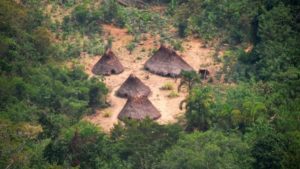One of the fundamental aspects of any carbon offsetting project is involvement with local people. Collaboration between project developers and proponents and the nearby involved communities is absolutely essential to delivering positive outcomes. In fact, it’s this collaboration that sets high-quality projects apart, as effective conservation is only achieved by ensuring the long-term and resilient empowerment of people and the improvement of their livelihoods.
At the Cordillera Azul National Park project in Peru, which is managed by CIMA and generates verified carbon offsets, working within a complex landscape of cultures is both a challenge and an opportunity. In the inhabited buffer zone of the national park, much work is being undertaken to partner with local people on alternative sustainable livelihoods, from cacao agroforestry to traditional handicrafts. These programmes and activities serve to empower local people, while reducing pressures on the National Park itself, especially the need to push into the forest for sustenance or income.
 But just as importantly to CIMA and to the stability of the cultural landscape, is ensuring the protection of an isolated indigenous group living within the confines of the Cordillera Azul National Park, specifically the Kakataibo people. Preserving indigenous rights has been a cornerstone value and objective for the National Park since its establishment in 2001. At this time, CIMA joined forces with government officials, indigenous leaders and anthropologists to understand and delineate all possible locations of these uncontacted indigenous communities within the park. Building on generational stories from local Kakataibo people, CIMA established a Zona de Protección Estricta, or intangible zone, which prohibited entry from outsiders. This Zona de Protección Estricta, which included a wide buffer to cover watersheds, is still in place today and protected by CIMA. Legally however, no mechanism was in place to confirm the reason for the creation of this zone.
But just as importantly to CIMA and to the stability of the cultural landscape, is ensuring the protection of an isolated indigenous group living within the confines of the Cordillera Azul National Park, specifically the Kakataibo people. Preserving indigenous rights has been a cornerstone value and objective for the National Park since its establishment in 2001. At this time, CIMA joined forces with government officials, indigenous leaders and anthropologists to understand and delineate all possible locations of these uncontacted indigenous communities within the park. Building on generational stories from local Kakataibo people, CIMA established a Zona de Protección Estricta, or intangible zone, which prohibited entry from outsiders. This Zona de Protección Estricta, which included a wide buffer to cover watersheds, is still in place today and protected by CIMA. Legally however, no mechanism was in place to confirm the reason for the creation of this zone.
This all changed recently when, through Supreme Decree, a territorial protection mechanism was officially pronounced which established an ‘Indigenous Reserve’ safeguarding the existence and integrity of Kakataibo people living in isolation within the park. This formally recognised reserve, which covers an area of almost 150,000 hectares of the Park, represents an important milestone in the protection of indigenous rights in Peru. Implemented by the Peruvian Ministry of Culture, it takes indigenous rights to the centre of government and dictates legal protection mechanisms to safeguard these people and their way of life. The government will work alongside CIMA and various public entities, civil society organisations and indigenous groups to ensure the protection of isolated Kakataibo people. This reserve is just another example of how climate finance is being used in this region of Peru to change local dynamics and safeguard indigenous communities who are and always will be key stewards of nature and critical to conservation outcomes.
See here to find out more about the Cordillera Azul National Park project, and contact us today to learn about our bespoke climate solutions.
Photo credit: CIMA
